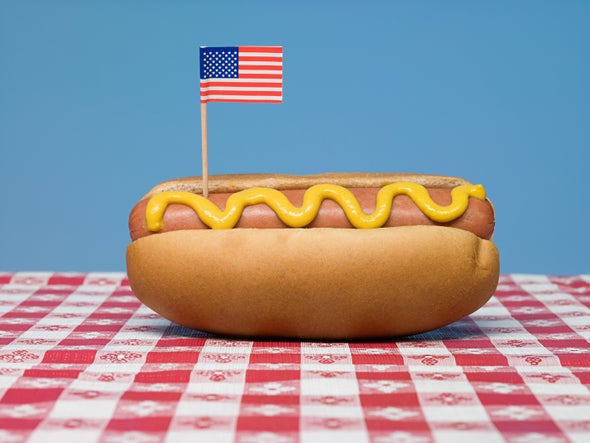(单词翻译:单击)
听力文本
This is Scientific American's 60-second Science, I'm Christopher Intagliata.
If you find yourself at a cookout this 4th of July, gazing at the hot dogs, wondering ... what exactly are they? Here's your answer:
"They're just tubes of fat." Tyler Rouse, a pathologist at the Stratford General Hospital in Ontario, Canada. And I may as well give a spoiler alert before continuing this story, because "I've ruined hot dogs for many people."
A couple years back, Rouse, too, was wondering about the composition of franks. Given his day job, "I said, that's an easy answer to find out. We work in a lab, we make slides all day. Hot dogs are kind of the perfect shape to make into a slide. We can actually answer this question."

So he and his colleague Jordan Radigan got their hands on three types of dogs: a no-name brand from the supermarket, another all-beef dog and a third from a ballpark vendor. They then took cross sections for slides and used stains to identify different types of tissue. And found, to their surprise, that most slices consisted primarily of fat globules, with very little skeletal muscle—the stuff we tend to think of as "meat." In fact, the no-name brand actually had more skeletal muscle than the all-beef brand. The researchers also found bits of bone and blood vessels and cartilage—even plant material. How did vegetable matter get in there?
"Let me put it this way. Sometimes I get biopsies from human colons and I find vegetable matter. I'll just leave it at that." The results were published in the Medical Journal of Australia.
But there's one thing they didn't find: tissue from the lips or anuses of animals—putting to rest that urban legend, at least for this study sample.
Nevertheless, "I will admit that my hot dog consumption dropped to nearly zero."
Thanks for listening for Scientific American — 60-Second Science. I'm Christopher Intagliata.
参考译文
这里是科学美国人——60秒科学系列,我是克里斯托弗·因塔格里塔。
如果你发现自已在7月4日野餐时盯着热狗看,并好奇:它们到底是什么?以下是你问题的答案:
“它们只是一管管脂肪。”加拿大安大略省斯特拉特福德综合医院的病理学家泰勒·罗斯说到。在继续这个故事之前,我不妨给大家一个剧透警告,因为“我已经毁掉了许多人的热狗。”
几年前,罗斯也想知道热狗的组成成分。考虑到他的日常工作,“我说,这是一个很容易找到的答案。我们在实验室工作,整天都在制作载片。热狗拥有制作成载片的完美形状。我们完全可以回答这个问题。”
因此,他和同事乔丹·拉迪根找来了三种热狗:超市里售卖的无牌热狗、全牛肉热狗以及棒球场小贩卖的热狗。之后,他们取了横截面制作载片,并用染色剂来辨别不同种类的组织。令他们惊讶的是,他们发现大多数载片的主要成分是脂肪球,以及极少量的骨骼肌——也就是我们通常视为“肉”的东西。事实上,无牌热狗所含的骨骼肌比全牛肉品牌还要多。研究人员还发现了一些骨骼、血管和软骨——甚至植物物质。热狗里怎么会有植物性物质呢?
“这样说吧。有时我从人类结肠提取活组织,会发现植物性物质。我就放在那里不管了。”研究结果发表在《澳大利亚医学期刊》上。
但有一种物质他们没找到:动物的口唇或肛门组织——至少就这个研究样本来说,这平息了城市传说。
然而,“我会承认我的热狗食用量几乎降到了零点。”
谢谢大家收听科学美国人——60秒科学。我是克里斯托弗·因塔利亚塔。
译文为可可英语翻译,未经授权请勿转载!
重点讲解
重点讲解:
1. gaze at 凝视;注视;盯着看;
She stood gazing at herself in the mirror.
她站在那儿,凝视着镜中的自己。
2. may as well 只好(做);(做…)也无妨;
If I've got to go somewhere I may as well go to Birmingham.
如果要去什么地方,那就去伯明翰吧。
3. get one's hands on (通常指经过努力后)获得,得到;
Patty began reading everything she could get her hands on.
帕蒂开始阅读她能找到的所有东西。
4. consist of 由…组成;由…构成;
Her crew consisted of children from Devon and Cornwall.
她的团队由来自德文郡和康沃尔郡的孩子们组成。


